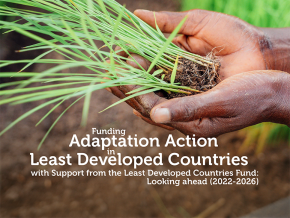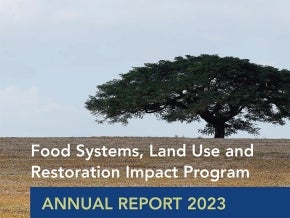Sand dams save lives: Improving water access & enhancing farming in response to Somalia's drought

Mohamed Ismail Yasin, originally from Mayle village in northeast Somalia, fled the region’s prolonged and severe drought with his six-member family and most of his livestock.
They had to travel 600km to the nearest dependable water source: a sand dam near Bandarbeyla in neighbouring Bari region.
Mohamed is one of 615,000 people currently displaced by the drought in Somalia.
Although the heavy seasonal rains have finally started, the long drought has already caused massive displacement and devastated herds.
Somalia is one of at least four countries facing a looming famine, and the humanitarian situation in Somalia is now rapidly deteriorating. Parts of the country have not received rain for three consecutive years. In the worst-affected areas, crops have been wiped out and livestock have died; communities are being forced to sell assets and borrow food and money to survive.
Half of the population –6.2 million people out of the country’s 12.3 million - are acutely food insecure. Of these, 2.9 million are in need of urgent life-saving assistance. Widespread starvation is a very real possibility.
People fear a repeat of the 2011 famine that killed nearly 260,000 people, half of them children. The current situation portends a potentially worse outcome - already more than five times as many people have been displaced by drought in 2017, compared to the peak of the 2011 famine.
But famine can still be prevented. An innovative water management solution is helping to deliver both immediate relief and long term solutions to drought and famine by providing a stable source of water which persists despite the changing weather patterns.
The Biyo-Gadud sand dam near Banderbeyla is one of the water harvesting structures implemented in Puntland to reduce the impacts of climate change-induced disasters like droughts and floods. Completed by the Puntland Ministry of Environment, through a Global Environment Facility-financed, UNDP-supported project, the sand dam is saving livestock and saving lives. The sand dam is working to help curb the effects of seasonal droughts and climate change for the Dhudo community, and the internally displaced peoples from wider Somalia.
Due to the ongoing drought in Puntland, water prices have been rising dramatically and a family with an average sized livestock herd might pay around $200 or up to $400 per month for water, or $7-14 per day depending on livestock size. These rising costs can be catastrophic for families.
For Mohamed Ismail Yasin and his family, the water dam has been a life- and money saver.
"In Mayle, we used to buy water for our livestock - after we arrived and the community told us about the water dam, now we can save this money.”
The $200 -$400 a month he used to be charged for water can now be put towards other basic needs for his family.
The sand dam is just one initiative UNDP has implemented under the Enhancing Climate Resilience of Vulnerable Communities and Ecosystems in Somalia project. Under the project, which is financed through the Global Environment Facility’s (GEF) Least Developed Countries Fund, UNDP is working with the Federal Government of Somalia to bolster the resilience of vulnerable communities and ecosystems to climate change in South West State, Galmudug State, Puntland, and Somaliland.
Building climate resilient systems can help people with food security, support the restoration of livelihoods, promote basic services to build resilience to recurrent shocks, and catalyse more sustainable solutions.
Enhancing climate-resilient farming will not stop droughts, but it will help prevent them from becoming famines. Building resilience to climatic events is critical for Somalia as the country stabilises after decades of conflict and commits to long-term development for its people.
Dry seasons and water shortages are persistent problems in the Puntland region of Somalia. The lack of rain restricts pastoralists from meeting their livestock’s water needs, which in turn diminishes the main source of their livelihood and the single largest contributor to Somalia's economy. Water shortages across Somalia also create acute stress and add to community tensions – no small matter in a country with internally displaced persons recovering from civil war.
Before the construction of the dam, people from the Dhudo community had no other option but to buy water from the berkades (traditional cemented water catchments). During water stress months, getting water from these berkades can cost approximately US$7-14 per day for each household of the pastoral communities to meet the water needs of their families and livestock. The placement of the berkades – far from villages - added to the difficulties of the local communities.

The dam has been strategically placed at a central location where nomadic people and communities from the region could access water supplies for livestock and agriculture. In December 2016, there were short spells of rains in the Bayla coastal district. The dam conserved an estimated 95,000m3 of surface water from these short rains, allowing people from the nearby districts to use the stored water for eight months.
As a result the dam is benefiting thousands of nomadic communities from surrounding areas who have migrated to this water source to escape drought stricken regions.
The current rainfall, especially when water is managed well, will allow farmers to plant crops and care for their livestock.
By strengthening and implementing climate change adaptation and disaster risk reduction at the local and national level, the project is providing humanitarian relief from drought and crisis, and enabling Somali people to build a climate resilient nation.
"Immediate humanitarian assistance is needed now. But in the long-term, building climate resilience in Somalia requires sustained investment in new technologies and enhanced capacities - at both the national and local level. Building resilience to future shocks is vital." - Tom Twining-Ward, UNDP Regional Technical Advisor
UNDP is supporting regional and local governments to improve water access and management through the development of water reservoirs, diversion and storage structures. UNDP is advocating for stronger climate change resilience through better collaboration between development and humanitarian partners.
For more information on this specific project, please visit: Enhancing Climate Resilience of the Vulnerable Communities and Ecosystems in Somalia
This story was originally published by UNDP.


